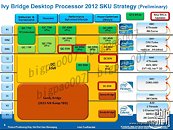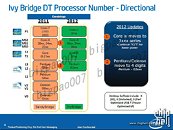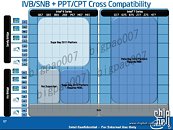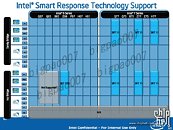- Joined
- Oct 9, 2007
- Messages
- 47,233 (7.55/day)
- Location
- Hyderabad, India
| System Name | RBMK-1000 |
|---|---|
| Processor | AMD Ryzen 7 5700G |
| Motherboard | ASUS ROG Strix B450-E Gaming |
| Cooling | DeepCool Gammax L240 V2 |
| Memory | 2x 8GB G.Skill Sniper X |
| Video Card(s) | Palit GeForce RTX 2080 SUPER GameRock |
| Storage | Western Digital Black NVMe 512GB |
| Display(s) | BenQ 1440p 60 Hz 27-inch |
| Case | Corsair Carbide 100R |
| Audio Device(s) | ASUS SupremeFX S1220A |
| Power Supply | Cooler Master MWE Gold 650W |
| Mouse | ASUS ROG Strix Impact |
| Keyboard | Gamdias Hermes E2 |
| Software | Windows 11 Pro |
Intel's next generation "Ivy Bridge" Core processors slated for 2012 will mark the beginning of Intel's transition to the brand new 22 nanometer fab process. It looks like Ivy Bridge will significantly benefit from this transition, since Intel will raise the bar in terms of energy-efficiency. Even the fastest P1 (performance 1) tier quad-core chips will have TDP rated as low as 77W, down from the 95W Core i7 2600K, for example, has.
The punters at Intel marketing have sliced the market down to finer segments, to better address it. The market is sliced in terms of price-segments (vertical), and in terms of target users (horizontal). The two markers are independent of each other, yet they complement each other in pin-pointing areas of the market Intel can address. Ivy Bridge LGA1155 is restricted to P1 (performance tier 1) segment on the top, with higher tiers, along with HEDT (high-end desktop) being reserved for Sandy Bridge-E LGA2011, and future "Ivy Bridge-E". Horizontally, Intel will have "K" quad-core parts for Enthusiast, standard (locked) quad-core vPro for the Standard, "T" quad-core for Performance-optimized lifestyle, and "S" for Power-optimized lifestyle. Chaotic as it looks, the table below lays out the lineup perfectly.

Unlocked "K" and standard (locked) vPro quad-core parts have TDP of 77W, performance-optimized "T" quad-core parts at 65W, and power-optimized "S" quad-core parts at 45W. There are dual-core Core i3 parts, too, with TDP of 55W (35W for the "S" variants).
The P1 segment parts will fall within the Core i7-3700 series, these chips will have the full 8 MB L3 cache present on the Ivy Bridge silicon, and 4 cores with 8 threads (HyperThreading enabled). Just below P1 segment are the MS2 and MS1 segments, the MS2 segment will include quad-core parts with 6 MB L3 cache, and no HyperThreading. The top-most MS2 part will have an unlocked multiplier, much like today's Core i5-2500K. MS2 and MS1 segment parts will take up Core i5-3500 series, Core i5-3400 series, and Core i5-3300 series. There will be just one class of dual-core parts, in the power-optimized MS1 segment. These segments will get have an updated feature-set over the present generation, that includes AES-NI acceleration, PP-DRNG.

Dual-core parts will span across key low-end and value segments. The 55W dual-core silicon will form the bed for SKUs in all four horizontal segments, in T2, T1, and L3 vertical segments. T2 and T1 segment parts will carry the Core i3-3100 series SKUs. These chips will have HyperThreading technology enabled, along with AVX, and updated GPU feature-set. The L3 segment will house the cheapest Ivy Bridge processor, in the Pentium Dual-Core G2000 family. This chip will now support dual-channel DDR3-1600 MHz.
Moving on to backwards compatibility with current Intel 6-series chipset motherboards, let me kill the suspense here. Ivy Bridge will run on Intel 6-series chipset motherboards, provided:

Last but not the least, Intel Smart Response technology (SRT) will be updated to be more functional, and perform even better than it does. Intel will seggregate SRT support among both processors and chipsets. So to be able to use SRT, besides having a compatible chipset, you'll also need a compatible processor. Future Q77, Z77, and H77 chipsets will support SRT, on Core i3, Core i5, and Core i7 processors.

View at TechPowerUp Main Site
The punters at Intel marketing have sliced the market down to finer segments, to better address it. The market is sliced in terms of price-segments (vertical), and in terms of target users (horizontal). The two markers are independent of each other, yet they complement each other in pin-pointing areas of the market Intel can address. Ivy Bridge LGA1155 is restricted to P1 (performance tier 1) segment on the top, with higher tiers, along with HEDT (high-end desktop) being reserved for Sandy Bridge-E LGA2011, and future "Ivy Bridge-E". Horizontally, Intel will have "K" quad-core parts for Enthusiast, standard (locked) quad-core vPro for the Standard, "T" quad-core for Performance-optimized lifestyle, and "S" for Power-optimized lifestyle. Chaotic as it looks, the table below lays out the lineup perfectly.

Unlocked "K" and standard (locked) vPro quad-core parts have TDP of 77W, performance-optimized "T" quad-core parts at 65W, and power-optimized "S" quad-core parts at 45W. There are dual-core Core i3 parts, too, with TDP of 55W (35W for the "S" variants).
The P1 segment parts will fall within the Core i7-3700 series, these chips will have the full 8 MB L3 cache present on the Ivy Bridge silicon, and 4 cores with 8 threads (HyperThreading enabled). Just below P1 segment are the MS2 and MS1 segments, the MS2 segment will include quad-core parts with 6 MB L3 cache, and no HyperThreading. The top-most MS2 part will have an unlocked multiplier, much like today's Core i5-2500K. MS2 and MS1 segment parts will take up Core i5-3500 series, Core i5-3400 series, and Core i5-3300 series. There will be just one class of dual-core parts, in the power-optimized MS1 segment. These segments will get have an updated feature-set over the present generation, that includes AES-NI acceleration, PP-DRNG.

Dual-core parts will span across key low-end and value segments. The 55W dual-core silicon will form the bed for SKUs in all four horizontal segments, in T2, T1, and L3 vertical segments. T2 and T1 segment parts will carry the Core i3-3100 series SKUs. These chips will have HyperThreading technology enabled, along with AVX, and updated GPU feature-set. The L3 segment will house the cheapest Ivy Bridge processor, in the Pentium Dual-Core G2000 family. This chip will now support dual-channel DDR3-1600 MHz.
Moving on to backwards compatibility with current Intel 6-series chipset motherboards, let me kill the suspense here. Ivy Bridge will run on Intel 6-series chipset motherboards, provided:
- They use the following chipsets: Z68, P67, H67, or H61 (Q67 and Q65 are not supported);
- The motherboards feature ME8L UEFI update. For this:
o Your motherboard should currently feature a UEFI firmware
o It should support ME8L update process at the physical level, where the EEPROM is sufficiently large

Last but not the least, Intel Smart Response technology (SRT) will be updated to be more functional, and perform even better than it does. Intel will seggregate SRT support among both processors and chipsets. So to be able to use SRT, besides having a compatible chipset, you'll also need a compatible processor. Future Q77, Z77, and H77 chipsets will support SRT, on Core i3, Core i5, and Core i7 processors.

View at TechPowerUp Main Site
Last edited:





 I may upgrade eventually, but haven't had a real need to quite yet.
I may upgrade eventually, but haven't had a real need to quite yet.
